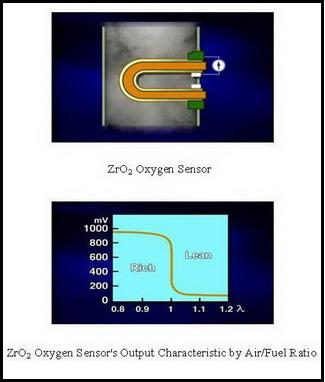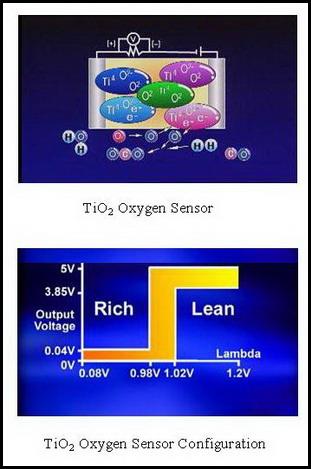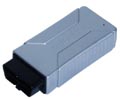- Oxygen Sensor
- |
- Sensors
- |
- Repair Basics
- |
- Technical Info
- |
- Car Tech Info
- |
- MicroTronik
Oxygen Sensor

O2 sensor TiO2 configuration

O2 sensor ZrO2 Configuration
(1) Outline
As air pollution has become a social issue, vehicle emission control has been enhanced. Auto makers have been developing various technologies. Among them, post-treatment of exhaust gas technology using three elements catalyzer is the most widely used one.
The Three elements catalyzer is simultaneously perform oxidation of HC, CO and de-oxidation of Nox to restrain generation of hazardous emission gas.The Three elements catalyzer demonstrated that purifying efficiency of HC, CO and Nox is highest around theoretical air/fuel ratio.
At thicker ratio than theoretical ratio, CO and HC emission is higher, and at thinner ratio than theoretical ratio Nox emission is higher. Therefore it is required to control that combustion to occur at theoretical air/fuel ratio, for effectual operation of 3 element catalyzer. It is called air/fuel ratio control or Lambda control.
For air/fuel ratio control, it is required check whether combustion is occur ring at theoretical ratio, and oxygen sensor is installed for this purpose. Oxygen sensor is a chemical voltage generation device that generates voltage depending oxygen concentration in emission gas.
Oxygen concentration gap with the ambient air is lower, and then lower voltage will be generated. On the other hand, if oxygen concentration is low (thicker combustion), and oxygen concentration gap with ambient air is higher, then higher voltage will be generated. In particularly the trend varies rapidly around theoretical ratio, and consequently oxygen sensor provides advantageous control of air/fuel ratio.
Typically oxygen sensor of the engine control system shall have the below characteristic:
- Provide rapid variation around theoretical air/fuel ratio.
- Rapid output voltage change by oxygen concentration variation in emission gas.
- No prominent difference between thicker and thinner ratio.
- Maintain stable voltage against emission gas temperature variation.
- ZrO2 sensors rely on electromotive force generated by oxygen concentration gap.
- TiO2 sensors rely on resistance variation by oxygen concentration gap.
(2) ZrO2 Oxygen Sensor
(1) Configuration and Measuring Principle:ZrO2 oxygen sensor is made by adding a little Yttrium (Y203) to ZrO2, and then forming it to test tube to make element, and finally coating platinum on both sides of element. Inner side contacts of the Sensor with ambient air and the outer side contacts with emission gas. ZrO2 element has high resistance and non-conductive at low temperature. At high temperature oxygen concentration gap will be high between inner and outer side, and only oxygen ions will pass through the element generating electromotive force. Each oxygen ion has 2 surplus electrons and consequently negative polarity. Therefore oxygen ions are attracted by ZrO2, and pulled toward inside of platinum pole-ZrO2 surface. Air contacting part of the Sensor has electrically negative polarity against emission gas, and then electric field exists between ZrO2 substances, resultantly generating potential gap. The potential gap is proportional to emission gas oxygen concentration and sensor temperature. Typically oxygen quantity existing in emission is expressed as partial pressure of the oxygen. The partial pressure is defined as partial pressure of the oxygen -to-emission gas pressure-ratio. In case of thicker mixture, the partial pressure of the oxygen ranges 1016~1032 of air pressure, and in case of thinner mixture approx. 1002.
(2) Sensor Output Characteristic
For thicker mixture oxygen concentration in emission gas is low with higher concentration gap resulting to higher potential gap.
For thinner mixture oxygen concentration in emission gas is high with low concentration gap resulting to lower potential gap.
As the change occurs around theoretical ratio, it is called switching characteristic. However, in actual combustion process the said change is not high enough. Therefore surface of the element is coated with porous platinum to provide enough concentration gap.
Platinum reaction of the catalyzer is as follows:
When platinum catalyzer burns thicker mixture residual O2 will almost completely react with CO, and remaining O2 on platinum surface will be nearly zero, generating higher oxygen concentration gap, and approx. 1V of electromotive force. In case of thinner mixture, O2 concentration in emission gas is high, and CO concentration is low. Therefore though co react with O2, oxygen concentration will not decrease significantly, and consequently the low concentration gap will generate almost no electromotive force. In addition hysteresis occurs when air/fuel ratio changes from thicker to thinner and when change from thinner to thicker. Then it will generate different responding characteristic of oxygen sensor between the two cases. To say required period of time between thicker-to-thinner and thinner-to-thicker is different.
Temperature has significant effect on output of the sensor characteristic. At temperature below 300 Degree C, sensor output varies rapidly by temperature, and hard to use for engine control. Above 300 C, sensor generates stable voltage of approx. 900mV for thicker ratio and approx. 100mV for thinner ratio.
Beside temperature has effect on switching time. It Required time changing from thicker to thinner ratio or thinner to thicker is approx. 3200ms and approx ms at 800. Therefore temperature variation may result to switching time of approx. 2:1.
(3) TiO2 Oxygen Sensor
TiO2 oxygen sensor is made by installing TiO2 element at the tip of ceramic insulator.
In addition platinum and rhodium catalyzer are used for improving sensor performance at low exhaust gas temperature. TiO2 oxygen sensor relies on electric resistance variation of electronic conductor-TiO2 responding to ambient partial pressure of oxygen. This sensor as characterized with rapidly changing resistance at the point of air/fuel ratio.(4) Oxygen Sensor Checking Procedure
Checking oxygen sensor involves first basic checks, to say connector connection, and circuit-break and short of the wiring, and thereafter analyze waveform of output signal. Normally periodic variation between (approximately below 200 mV and above 600 mV). When no abnormality is found but sensor output voltage is outside specified value, check items related to air/fuel ratio adjustment. To say, injector defect, air leak through gasket gap, air intake rate sensor defect, intake air temperature sensor defect, coolant temperature sensor, fuel pressure, etc above 0.5V, it implies thicker combustion, and then air intake rate sensor defect and injector leak shall be checked. If average output voltage is below 0.45V it indicates thinner combustion, requiring to check vacuum leak and sensor defect.In particular the resistance of ZrO2 oxygen sensor shall not be checked directly. As the oxygen sensor itself generates voltage, resistance measurement may damage the sensor. In order to decide whether oxygen sensor is faulty or oxygen output voltage is abnormal by faulty air/fuel ratio, approve 14V at oxygen sensor heater part terminal, and wait approx. 1~2minutes and then read sensor output voltage that shall be 10~100mV. If output voltage is OK, oxygen sensor may be normal, and then proceed to check other parts.
(5) Failure Symptom
- Faulty air/fuel ratio.
- Rapid acceleration is poor, or during driving acceleration is poor or engine goes off.
- Higher fuel consumption.
- Higher CO and HC emission.
You can check the sensor actual value and status by AutoHex auto Diagnostic Scanner under the supported car brand and according to engine type.
BMW ECU Programming
Description
Oxygen Sensor is used to enhance vehicle emission control with post-treatment of exhaust gas technology in the catalyzers , and it will effect on the fuel consumption and control High CO and HC emission.
Autohex II Reviews
AutoHex II
AutoHex II is your best choice to have full access to dealer functions like coding, adjusting and modules flashing/programming, Contact us for prices
AutoHex Forum


